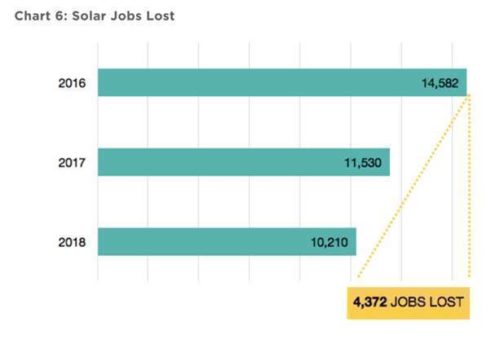 A report released by Vote Solar reveals that an inconsistent policy environment is dramatically slowing the growth of the Commonwealth’s solar industry, putting Massachusetts in danger of falling short when it comes to achieving its existing renewable energy and climate laws. “Clouds Over the Solar Industry in Massachusetts” identifies the specific and measurable steps the Commonwealth should undertake — notably tripling the Solar Massachusetts Renewable Target (SMART) program to 4,800 megawatts — which the report says would create 8,000 to 9,000 new in-state jobs, drive in more than $5 billion in solar project investment into the state’s economy and put the Commonwealth on track to achieve its carbon reduction target.
A report released by Vote Solar reveals that an inconsistent policy environment is dramatically slowing the growth of the Commonwealth’s solar industry, putting Massachusetts in danger of falling short when it comes to achieving its existing renewable energy and climate laws. “Clouds Over the Solar Industry in Massachusetts” identifies the specific and measurable steps the Commonwealth should undertake — notably tripling the Solar Massachusetts Renewable Target (SMART) program to 4,800 megawatts — which the report says would create 8,000 to 9,000 new in-state jobs, drive in more than $5 billion in solar project investment into the state’s economy and put the Commonwealth on track to achieve its carbon reduction target.
“Massachusetts is falling short of the path to our existing clean energy targets, which themselves lag behind neighbors like New York. Our short-term solar policies mean we are losing jobs, losing opportunities for families and businesses to save on their energy bills, and losing the battle to protect our climate, but we can change that,” said Sean Garren, Northeast senior director at Vote Solar. “Now is the time for the Commonwealth to commit to a bold path forward with local solar power, resilient energy storage, and an equitable distribution of the benefits of this clean transition.”
The report found that due in part to several changes in energy policy, the state has seen a 50% decline in new solar installations, predominantly in the residential sector. As a result, the state’s solar workforce has shrunk by about 30%, shedding around 4,372 jobs between 2015 and 2018. Many shovel-ready solar projects now languishing on waiting lists in two — soon to be three — utility territories further emphasize the need for immediate policy action.
 “Here in Massachusetts, we have a highly-skilled, highly-trained solar workforce that is ready to get our state back on track,” said Lisa A. Podgurski, manager of business development, International Brotherhood of Electrical Workers (IBEW) Local 103. “The SMART program needs to be expanded and strengthened, which will help spur job growth and get our solar workers back to work.”
“Here in Massachusetts, we have a highly-skilled, highly-trained solar workforce that is ready to get our state back on track,” said Lisa A. Podgurski, manager of business development, International Brotherhood of Electrical Workers (IBEW) Local 103. “The SMART program needs to be expanded and strengthened, which will help spur job growth and get our solar workers back to work.”
The current SMART incentive program calls for 1,600 MW of solar power in the state, a goal the report says is inadequate to capture the opportunities of solar energy development and comply with state renewable energy and climate laws. To help Massachusetts maximize local benefits and reclaim its national leadership, the newly released report includes several policy recommendations including:
- Expansion of the SMART program — to 4,800 MW, an increase of 3,200 MW — in order to meet the Commonwealth’s clean energy deployment goals under the Renewable Portfolio Standard (RPS) will help give solar workers confidence over a few years of consistent policy.
- Strong provisions for low-income access and equitable participation in the state’s growing clean energy economy through mechanisms such as contract-free community solar, focused incentive programs, and processes for initial and ongoing public stakeholder input in program design.
- Effective integration of energy storage and other distributed energy resources into the SMART program and utility grid planning to maximize both resilience and carbon reduction benefits of solar.
- Enable cities and towns, businesses and affordable housing to choose solar by addressing the net metering caps and SMART program design that are failing these customers.
News item from Vote Solar





Tell Us What You Think!